Engineering Project Management: Domestic Water and Soil Analysis
VerifiedAdded on 2023/06/03
|16
|3924
|317
Report
AI Summary
This report investigates the impact of domestic wastewater on soil properties, focusing on the physiochemical structure of the soil and the advantages and disadvantages of sewage water use. It explores the effects of wastewater irrigation on crops, highlighting improvements in soil nitrogen content and other beneficial properties. The literature review covers characteristics of domestic wastewater, its impact on physical and chemical soil properties, the distribution of heavy metals, and the effects on soil enzymes and microorganism activities. The study addresses research questions related to the advantages and disadvantages of domestic wastewater on soil characteristics around treatment plants and the overall impact of sewage irrigation on soil properties. The theoretical content suggests that domestic wastewater can be a rich source of organic and inorganic nutrients for plant growth, though its effects on soil health require careful management.
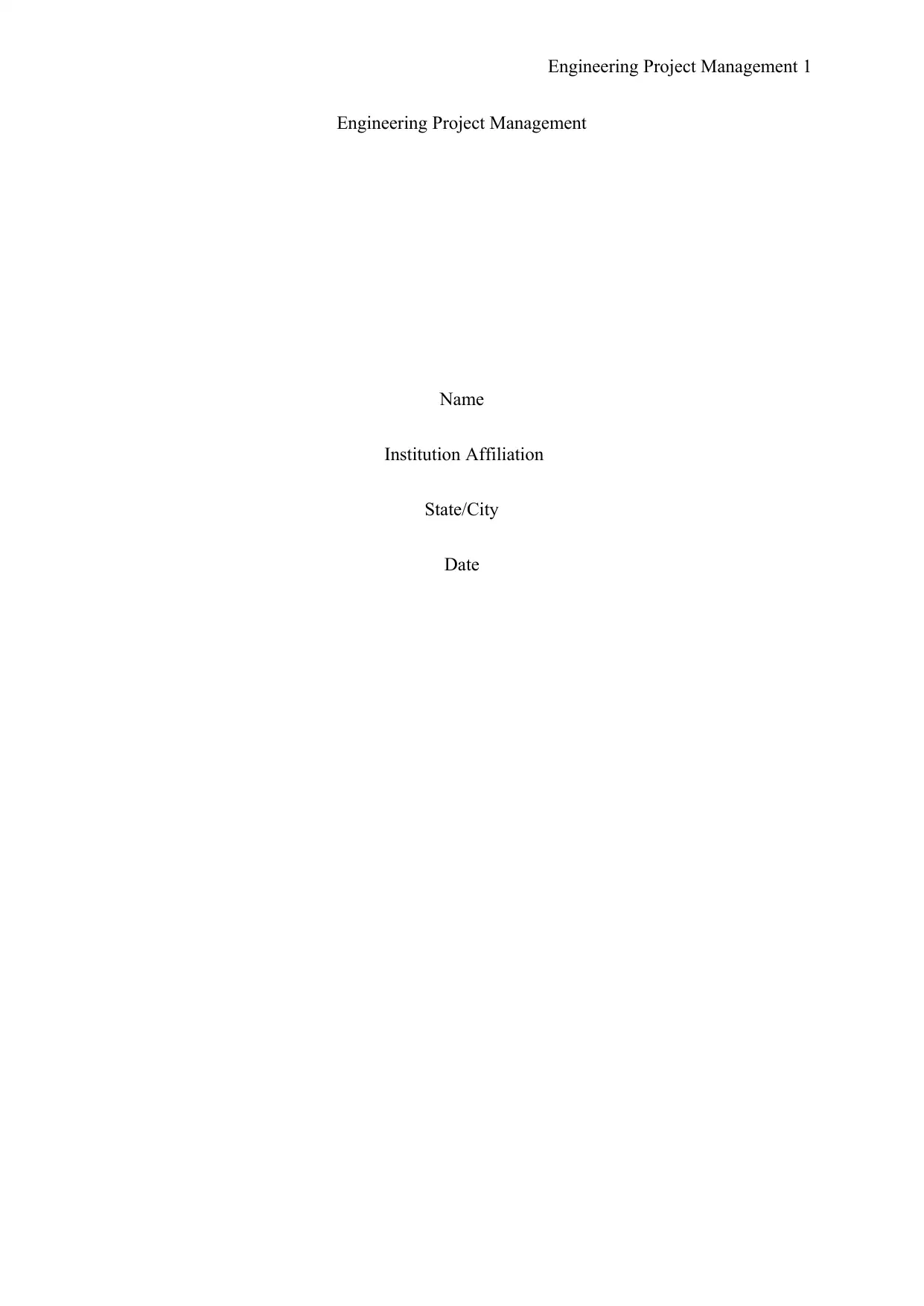
Engineering Project Management 1
Engineering Project Management
Name
Institution Affiliation
State/City
Date
Engineering Project Management
Name
Institution Affiliation
State/City
Date
Paraphrase This Document
Need a fresh take? Get an instant paraphrase of this document with our AI Paraphraser
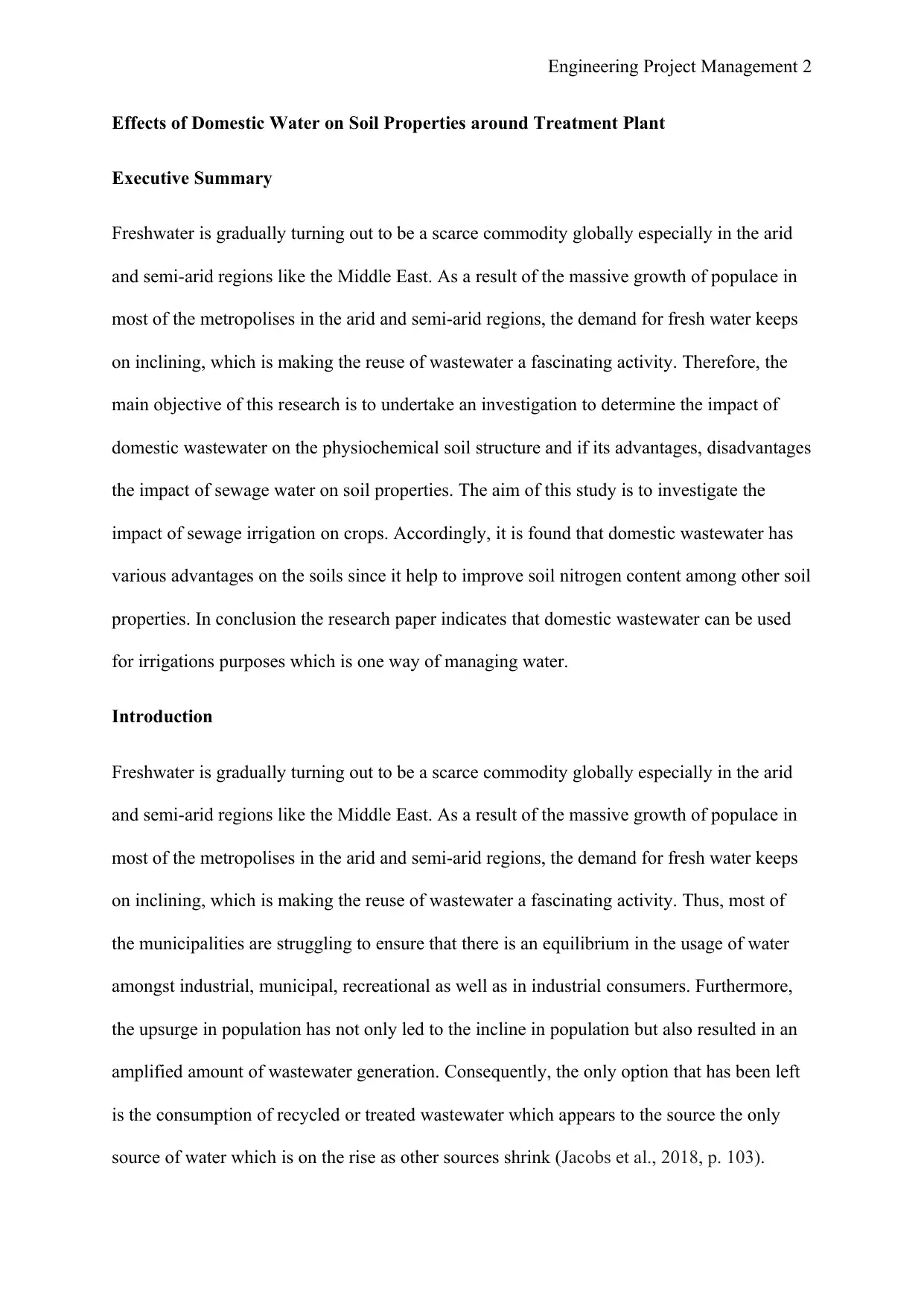
Engineering Project Management 2
Effects of Domestic Water on Soil Properties around Treatment Plant
Executive Summary
Freshwater is gradually turning out to be a scarce commodity globally especially in the arid
and semi-arid regions like the Middle East. As a result of the massive growth of populace in
most of the metropolises in the arid and semi-arid regions, the demand for fresh water keeps
on inclining, which is making the reuse of wastewater a fascinating activity. Therefore, the
main objective of this research is to undertake an investigation to determine the impact of
domestic wastewater on the physiochemical soil structure and if its advantages, disadvantages
the impact of sewage water on soil properties. The aim of this study is to investigate the
impact of sewage irrigation on crops. Accordingly, it is found that domestic wastewater has
various advantages on the soils since it help to improve soil nitrogen content among other soil
properties. In conclusion the research paper indicates that domestic wastewater can be used
for irrigations purposes which is one way of managing water.
Introduction
Freshwater is gradually turning out to be a scarce commodity globally especially in the arid
and semi-arid regions like the Middle East. As a result of the massive growth of populace in
most of the metropolises in the arid and semi-arid regions, the demand for fresh water keeps
on inclining, which is making the reuse of wastewater a fascinating activity. Thus, most of
the municipalities are struggling to ensure that there is an equilibrium in the usage of water
amongst industrial, municipal, recreational as well as in industrial consumers. Furthermore,
the upsurge in population has not only led to the incline in population but also resulted in an
amplified amount of wastewater generation. Consequently, the only option that has been left
is the consumption of recycled or treated wastewater which appears to the source the only
source of water which is on the rise as other sources shrink (Jacobs et al., 2018, p. 103).
Effects of Domestic Water on Soil Properties around Treatment Plant
Executive Summary
Freshwater is gradually turning out to be a scarce commodity globally especially in the arid
and semi-arid regions like the Middle East. As a result of the massive growth of populace in
most of the metropolises in the arid and semi-arid regions, the demand for fresh water keeps
on inclining, which is making the reuse of wastewater a fascinating activity. Therefore, the
main objective of this research is to undertake an investigation to determine the impact of
domestic wastewater on the physiochemical soil structure and if its advantages, disadvantages
the impact of sewage water on soil properties. The aim of this study is to investigate the
impact of sewage irrigation on crops. Accordingly, it is found that domestic wastewater has
various advantages on the soils since it help to improve soil nitrogen content among other soil
properties. In conclusion the research paper indicates that domestic wastewater can be used
for irrigations purposes which is one way of managing water.
Introduction
Freshwater is gradually turning out to be a scarce commodity globally especially in the arid
and semi-arid regions like the Middle East. As a result of the massive growth of populace in
most of the metropolises in the arid and semi-arid regions, the demand for fresh water keeps
on inclining, which is making the reuse of wastewater a fascinating activity. Thus, most of
the municipalities are struggling to ensure that there is an equilibrium in the usage of water
amongst industrial, municipal, recreational as well as in industrial consumers. Furthermore,
the upsurge in population has not only led to the incline in population but also resulted in an
amplified amount of wastewater generation. Consequently, the only option that has been left
is the consumption of recycled or treated wastewater which appears to the source the only
source of water which is on the rise as other sources shrink (Jacobs et al., 2018, p. 103).
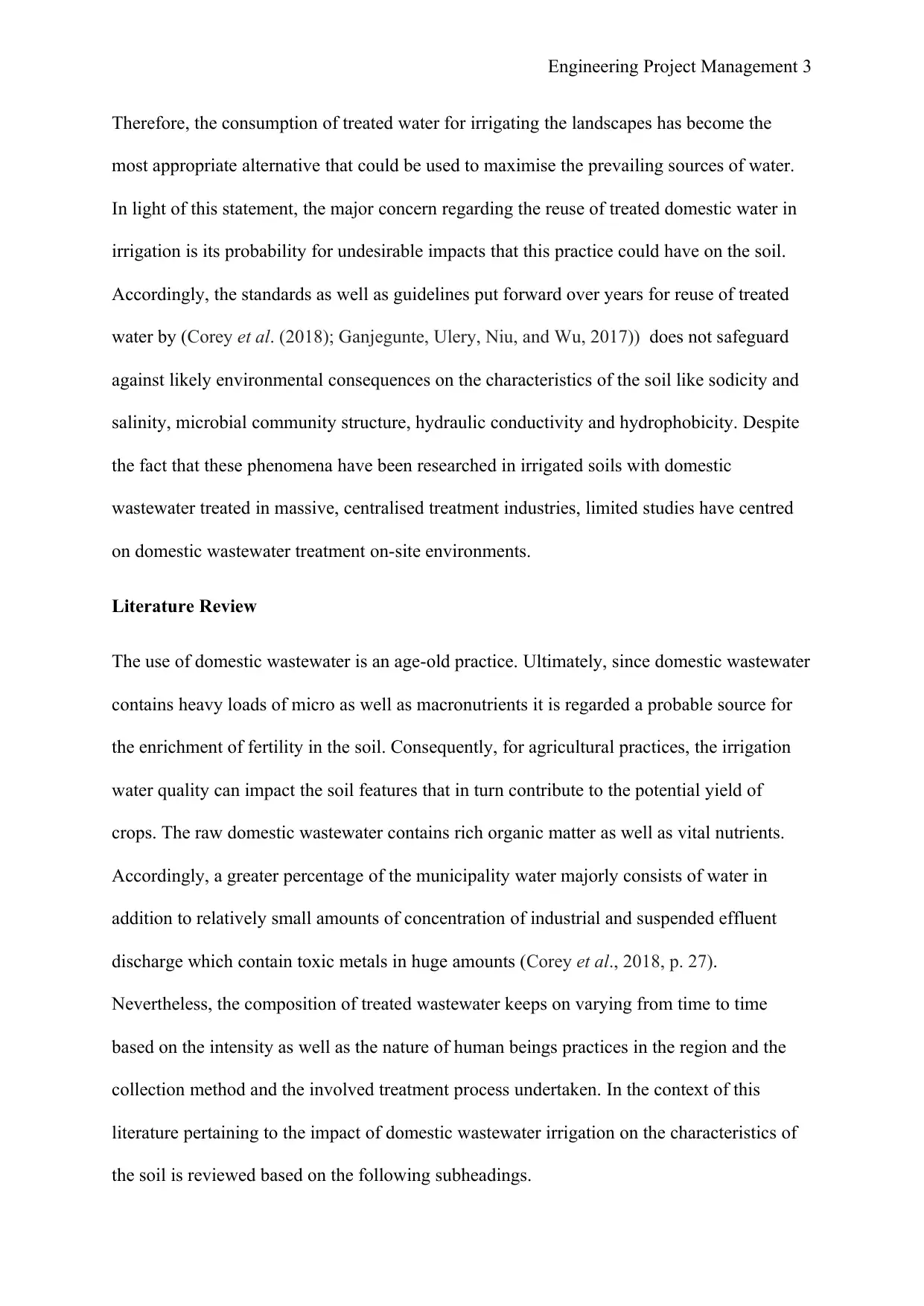
Engineering Project Management 3
Therefore, the consumption of treated water for irrigating the landscapes has become the
most appropriate alternative that could be used to maximise the prevailing sources of water.
In light of this statement, the major concern regarding the reuse of treated domestic water in
irrigation is its probability for undesirable impacts that this practice could have on the soil.
Accordingly, the standards as well as guidelines put forward over years for reuse of treated
water by (Corey et al. (2018); Ganjegunte, Ulery, Niu, and Wu, 2017)) does not safeguard
against likely environmental consequences on the characteristics of the soil like sodicity and
salinity, microbial community structure, hydraulic conductivity and hydrophobicity. Despite
the fact that these phenomena have been researched in irrigated soils with domestic
wastewater treated in massive, centralised treatment industries, limited studies have centred
on domestic wastewater treatment on-site environments.
Literature Review
The use of domestic wastewater is an age-old practice. Ultimately, since domestic wastewater
contains heavy loads of micro as well as macronutrients it is regarded a probable source for
the enrichment of fertility in the soil. Consequently, for agricultural practices, the irrigation
water quality can impact the soil features that in turn contribute to the potential yield of
crops. The raw domestic wastewater contains rich organic matter as well as vital nutrients.
Accordingly, a greater percentage of the municipality water majorly consists of water in
addition to relatively small amounts of concentration of industrial and suspended effluent
discharge which contain toxic metals in huge amounts (Corey et al., 2018, p. 27).
Nevertheless, the composition of treated wastewater keeps on varying from time to time
based on the intensity as well as the nature of human beings practices in the region and the
collection method and the involved treatment process undertaken. In the context of this
literature pertaining to the impact of domestic wastewater irrigation on the characteristics of
the soil is reviewed based on the following subheadings.
Therefore, the consumption of treated water for irrigating the landscapes has become the
most appropriate alternative that could be used to maximise the prevailing sources of water.
In light of this statement, the major concern regarding the reuse of treated domestic water in
irrigation is its probability for undesirable impacts that this practice could have on the soil.
Accordingly, the standards as well as guidelines put forward over years for reuse of treated
water by (Corey et al. (2018); Ganjegunte, Ulery, Niu, and Wu, 2017)) does not safeguard
against likely environmental consequences on the characteristics of the soil like sodicity and
salinity, microbial community structure, hydraulic conductivity and hydrophobicity. Despite
the fact that these phenomena have been researched in irrigated soils with domestic
wastewater treated in massive, centralised treatment industries, limited studies have centred
on domestic wastewater treatment on-site environments.
Literature Review
The use of domestic wastewater is an age-old practice. Ultimately, since domestic wastewater
contains heavy loads of micro as well as macronutrients it is regarded a probable source for
the enrichment of fertility in the soil. Consequently, for agricultural practices, the irrigation
water quality can impact the soil features that in turn contribute to the potential yield of
crops. The raw domestic wastewater contains rich organic matter as well as vital nutrients.
Accordingly, a greater percentage of the municipality water majorly consists of water in
addition to relatively small amounts of concentration of industrial and suspended effluent
discharge which contain toxic metals in huge amounts (Corey et al., 2018, p. 27).
Nevertheless, the composition of treated wastewater keeps on varying from time to time
based on the intensity as well as the nature of human beings practices in the region and the
collection method and the involved treatment process undertaken. In the context of this
literature pertaining to the impact of domestic wastewater irrigation on the characteristics of
the soil is reviewed based on the following subheadings.
⊘ This is a preview!⊘
Do you want full access?
Subscribe today to unlock all pages.

Trusted by 1+ million students worldwide
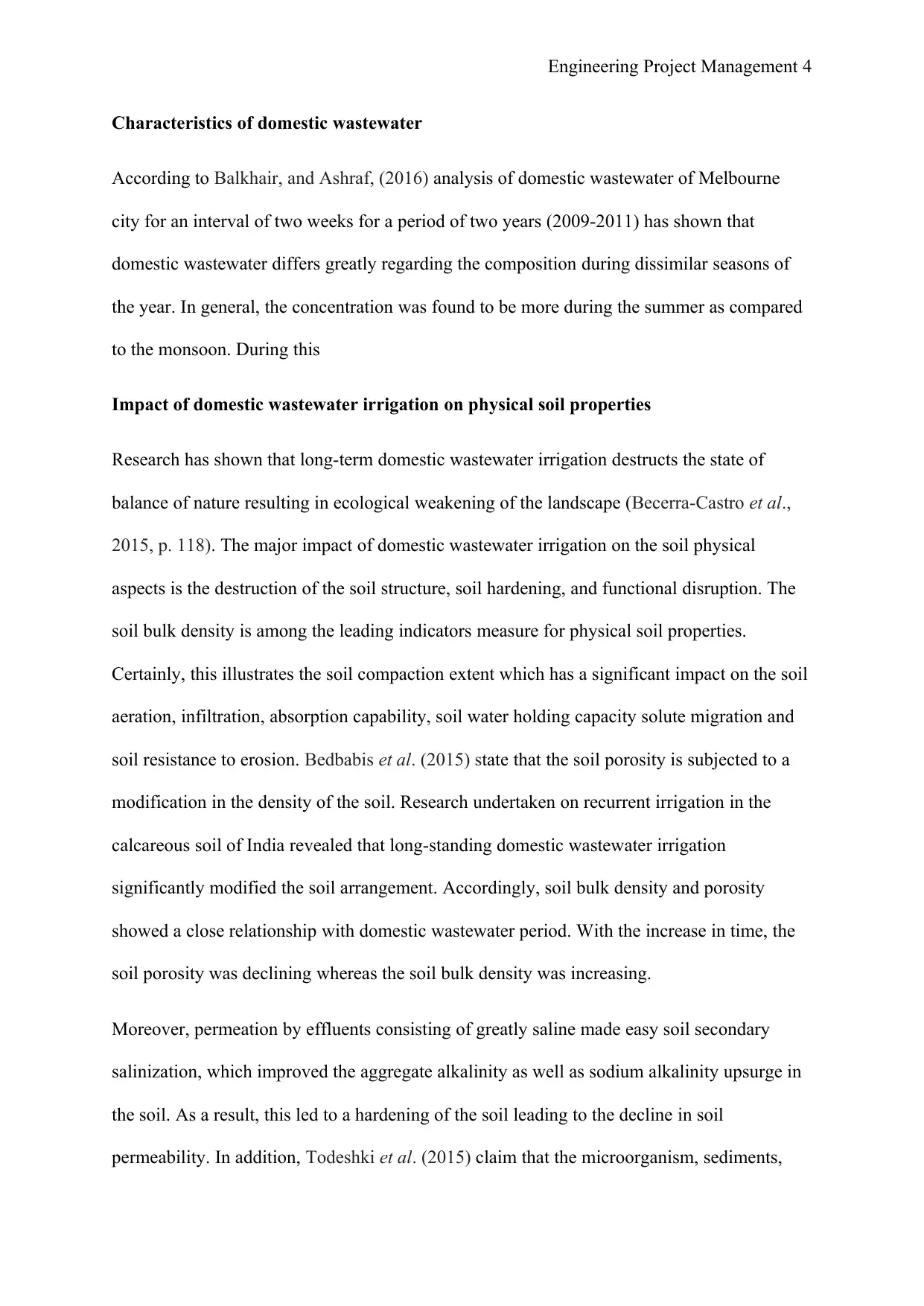
Engineering Project Management 4
Characteristics of domestic wastewater
According to Balkhair, and Ashraf, (2016) analysis of domestic wastewater of Melbourne
city for an interval of two weeks for a period of two years (2009-2011) has shown that
domestic wastewater differs greatly regarding the composition during dissimilar seasons of
the year. In general, the concentration was found to be more during the summer as compared
to the monsoon. During this
Impact of domestic wastewater irrigation on physical soil properties
Research has shown that long-term domestic wastewater irrigation destructs the state of
balance of nature resulting in ecological weakening of the landscape (Becerra-Castro et al.,
2015, p. 118). The major impact of domestic wastewater irrigation on the soil physical
aspects is the destruction of the soil structure, soil hardening, and functional disruption. The
soil bulk density is among the leading indicators measure for physical soil properties.
Certainly, this illustrates the soil compaction extent which has a significant impact on the soil
aeration, infiltration, absorption capability, soil water holding capacity solute migration and
soil resistance to erosion. Bedbabis et al. (2015) state that the soil porosity is subjected to a
modification in the density of the soil. Research undertaken on recurrent irrigation in the
calcareous soil of India revealed that long-standing domestic wastewater irrigation
significantly modified the soil arrangement. Accordingly, soil bulk density and porosity
showed a close relationship with domestic wastewater period. With the increase in time, the
soil porosity was declining whereas the soil bulk density was increasing.
Moreover, permeation by effluents consisting of greatly saline made easy soil secondary
salinization, which improved the aggregate alkalinity as well as sodium alkalinity upsurge in
the soil. As a result, this led to a hardening of the soil leading to the decline in soil
permeability. In addition, Todeshki et al. (2015) claim that the microorganism, sediments,
Characteristics of domestic wastewater
According to Balkhair, and Ashraf, (2016) analysis of domestic wastewater of Melbourne
city for an interval of two weeks for a period of two years (2009-2011) has shown that
domestic wastewater differs greatly regarding the composition during dissimilar seasons of
the year. In general, the concentration was found to be more during the summer as compared
to the monsoon. During this
Impact of domestic wastewater irrigation on physical soil properties
Research has shown that long-term domestic wastewater irrigation destructs the state of
balance of nature resulting in ecological weakening of the landscape (Becerra-Castro et al.,
2015, p. 118). The major impact of domestic wastewater irrigation on the soil physical
aspects is the destruction of the soil structure, soil hardening, and functional disruption. The
soil bulk density is among the leading indicators measure for physical soil properties.
Certainly, this illustrates the soil compaction extent which has a significant impact on the soil
aeration, infiltration, absorption capability, soil water holding capacity solute migration and
soil resistance to erosion. Bedbabis et al. (2015) state that the soil porosity is subjected to a
modification in the density of the soil. Research undertaken on recurrent irrigation in the
calcareous soil of India revealed that long-standing domestic wastewater irrigation
significantly modified the soil arrangement. Accordingly, soil bulk density and porosity
showed a close relationship with domestic wastewater period. With the increase in time, the
soil porosity was declining whereas the soil bulk density was increasing.
Moreover, permeation by effluents consisting of greatly saline made easy soil secondary
salinization, which improved the aggregate alkalinity as well as sodium alkalinity upsurge in
the soil. As a result, this led to a hardening of the soil leading to the decline in soil
permeability. In addition, Todeshki et al. (2015) claim that the microorganism, sediments,
Paraphrase This Document
Need a fresh take? Get an instant paraphrase of this document with our AI Paraphraser
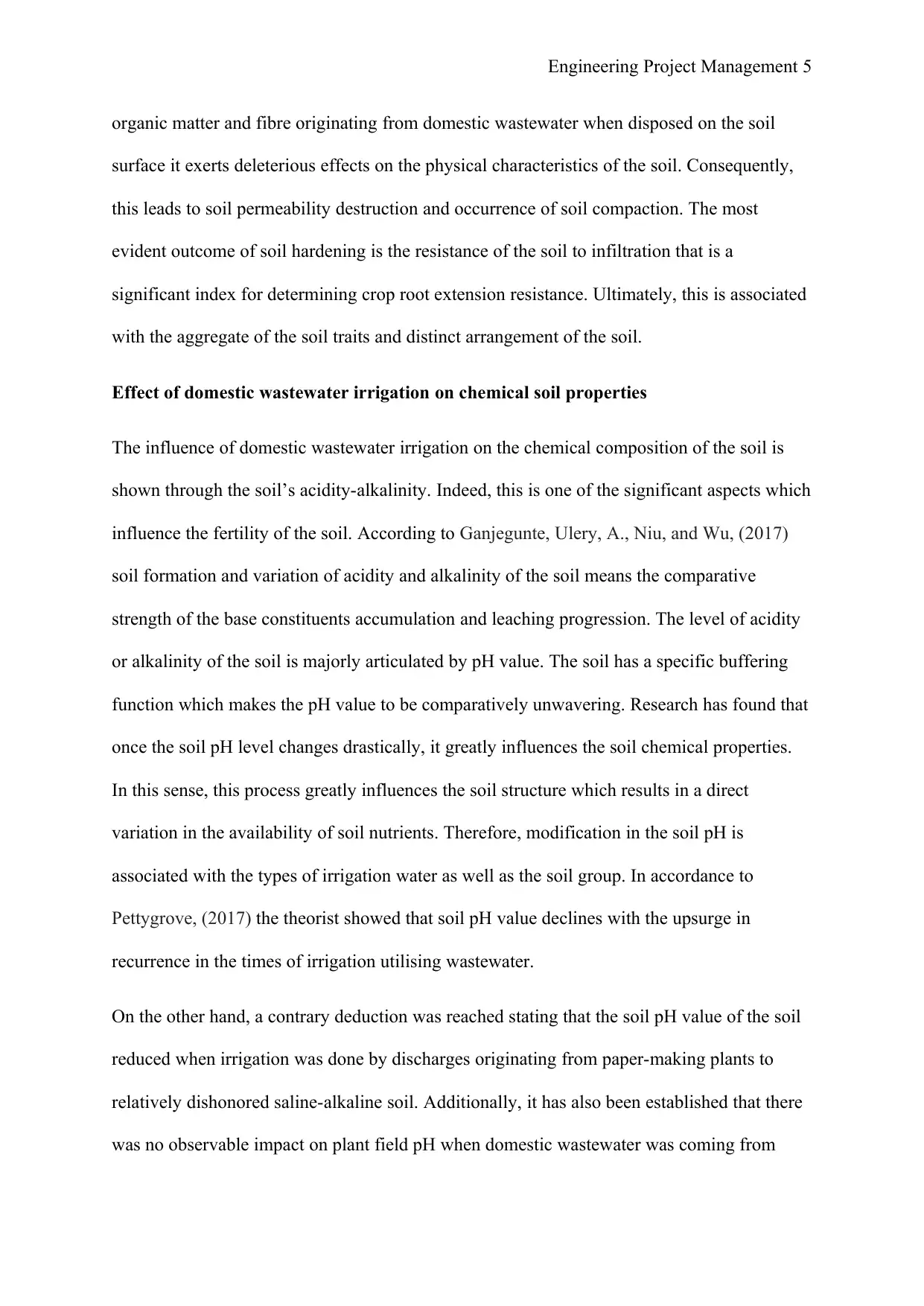
Engineering Project Management 5
organic matter and fibre originating from domestic wastewater when disposed on the soil
surface it exerts deleterious effects on the physical characteristics of the soil. Consequently,
this leads to soil permeability destruction and occurrence of soil compaction. The most
evident outcome of soil hardening is the resistance of the soil to infiltration that is a
significant index for determining crop root extension resistance. Ultimately, this is associated
with the aggregate of the soil traits and distinct arrangement of the soil.
Effect of domestic wastewater irrigation on chemical soil properties
The influence of domestic wastewater irrigation on the chemical composition of the soil is
shown through the soil’s acidity-alkalinity. Indeed, this is one of the significant aspects which
influence the fertility of the soil. According to Ganjegunte, Ulery, A., Niu, and Wu, (2017)
soil formation and variation of acidity and alkalinity of the soil means the comparative
strength of the base constituents accumulation and leaching progression. The level of acidity
or alkalinity of the soil is majorly articulated by pH value. The soil has a specific buffering
function which makes the pH value to be comparatively unwavering. Research has found that
once the soil pH level changes drastically, it greatly influences the soil chemical properties.
In this sense, this process greatly influences the soil structure which results in a direct
variation in the availability of soil nutrients. Therefore, modification in the soil pH is
associated with the types of irrigation water as well as the soil group. In accordance to
Pettygrove, (2017) the theorist showed that soil pH value declines with the upsurge in
recurrence in the times of irrigation utilising wastewater.
On the other hand, a contrary deduction was reached stating that the soil pH value of the soil
reduced when irrigation was done by discharges originating from paper-making plants to
relatively dishonored saline-alkaline soil. Additionally, it has also been established that there
was no observable impact on plant field pH when domestic wastewater was coming from
organic matter and fibre originating from domestic wastewater when disposed on the soil
surface it exerts deleterious effects on the physical characteristics of the soil. Consequently,
this leads to soil permeability destruction and occurrence of soil compaction. The most
evident outcome of soil hardening is the resistance of the soil to infiltration that is a
significant index for determining crop root extension resistance. Ultimately, this is associated
with the aggregate of the soil traits and distinct arrangement of the soil.
Effect of domestic wastewater irrigation on chemical soil properties
The influence of domestic wastewater irrigation on the chemical composition of the soil is
shown through the soil’s acidity-alkalinity. Indeed, this is one of the significant aspects which
influence the fertility of the soil. According to Ganjegunte, Ulery, A., Niu, and Wu, (2017)
soil formation and variation of acidity and alkalinity of the soil means the comparative
strength of the base constituents accumulation and leaching progression. The level of acidity
or alkalinity of the soil is majorly articulated by pH value. The soil has a specific buffering
function which makes the pH value to be comparatively unwavering. Research has found that
once the soil pH level changes drastically, it greatly influences the soil chemical properties.
In this sense, this process greatly influences the soil structure which results in a direct
variation in the availability of soil nutrients. Therefore, modification in the soil pH is
associated with the types of irrigation water as well as the soil group. In accordance to
Pettygrove, (2017) the theorist showed that soil pH value declines with the upsurge in
recurrence in the times of irrigation utilising wastewater.
On the other hand, a contrary deduction was reached stating that the soil pH value of the soil
reduced when irrigation was done by discharges originating from paper-making plants to
relatively dishonored saline-alkaline soil. Additionally, it has also been established that there
was no observable impact on plant field pH when domestic wastewater was coming from
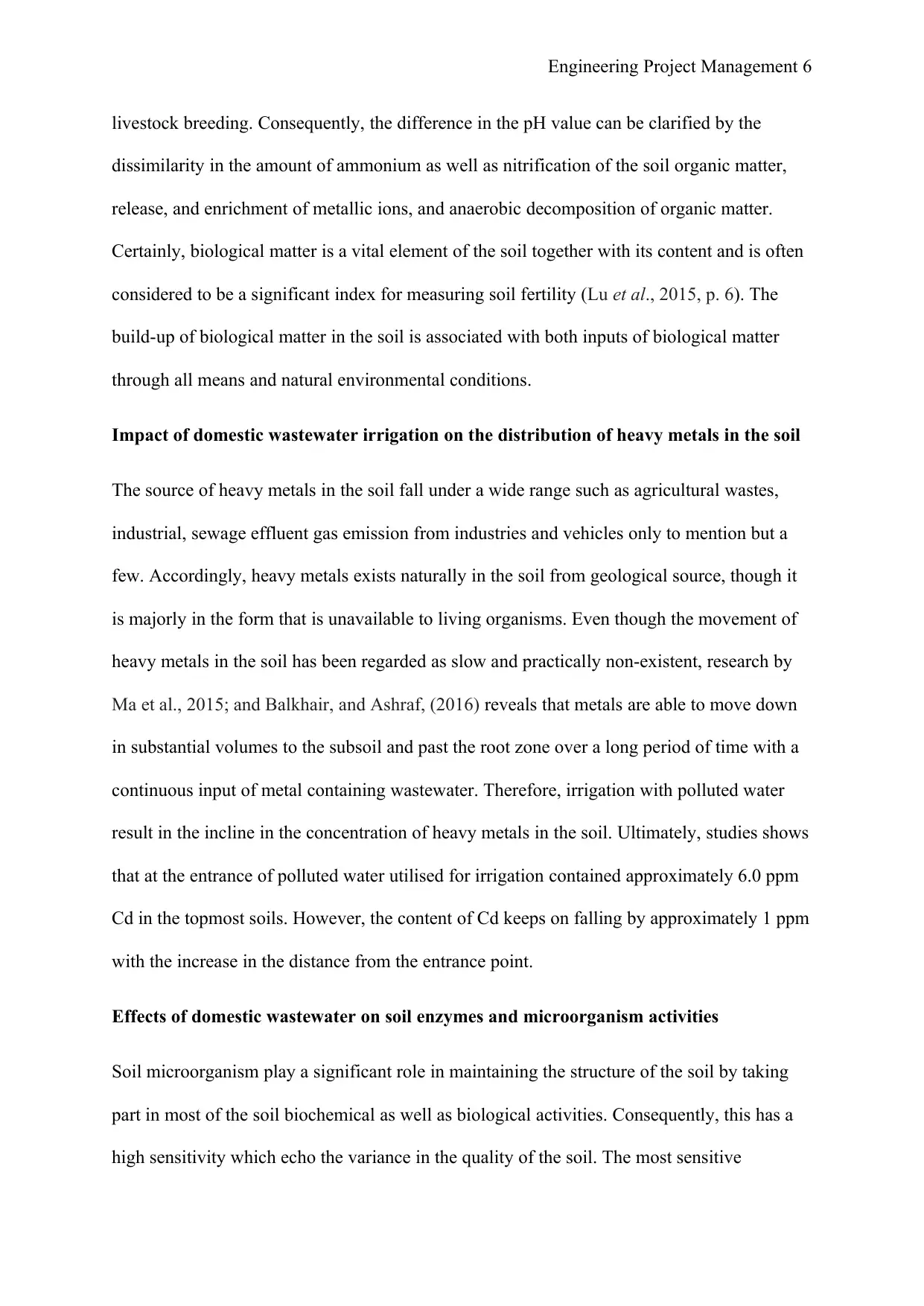
Engineering Project Management 6
livestock breeding. Consequently, the difference in the pH value can be clarified by the
dissimilarity in the amount of ammonium as well as nitrification of the soil organic matter,
release, and enrichment of metallic ions, and anaerobic decomposition of organic matter.
Certainly, biological matter is a vital element of the soil together with its content and is often
considered to be a significant index for measuring soil fertility (Lu et al., 2015, p. 6). The
build-up of biological matter in the soil is associated with both inputs of biological matter
through all means and natural environmental conditions.
Impact of domestic wastewater irrigation on the distribution of heavy metals in the soil
The source of heavy metals in the soil fall under a wide range such as agricultural wastes,
industrial, sewage effluent gas emission from industries and vehicles only to mention but a
few. Accordingly, heavy metals exists naturally in the soil from geological source, though it
is majorly in the form that is unavailable to living organisms. Even though the movement of
heavy metals in the soil has been regarded as slow and practically non-existent, research by
Ma et al., 2015; and Balkhair, and Ashraf, (2016) reveals that metals are able to move down
in substantial volumes to the subsoil and past the root zone over a long period of time with a
continuous input of metal containing wastewater. Therefore, irrigation with polluted water
result in the incline in the concentration of heavy metals in the soil. Ultimately, studies shows
that at the entrance of polluted water utilised for irrigation contained approximately 6.0 ppm
Cd in the topmost soils. However, the content of Cd keeps on falling by approximately 1 ppm
with the increase in the distance from the entrance point.
Effects of domestic wastewater on soil enzymes and microorganism activities
Soil microorganism play a significant role in maintaining the structure of the soil by taking
part in most of the soil biochemical as well as biological activities. Consequently, this has a
high sensitivity which echo the variance in the quality of the soil. The most sensitive
livestock breeding. Consequently, the difference in the pH value can be clarified by the
dissimilarity in the amount of ammonium as well as nitrification of the soil organic matter,
release, and enrichment of metallic ions, and anaerobic decomposition of organic matter.
Certainly, biological matter is a vital element of the soil together with its content and is often
considered to be a significant index for measuring soil fertility (Lu et al., 2015, p. 6). The
build-up of biological matter in the soil is associated with both inputs of biological matter
through all means and natural environmental conditions.
Impact of domestic wastewater irrigation on the distribution of heavy metals in the soil
The source of heavy metals in the soil fall under a wide range such as agricultural wastes,
industrial, sewage effluent gas emission from industries and vehicles only to mention but a
few. Accordingly, heavy metals exists naturally in the soil from geological source, though it
is majorly in the form that is unavailable to living organisms. Even though the movement of
heavy metals in the soil has been regarded as slow and practically non-existent, research by
Ma et al., 2015; and Balkhair, and Ashraf, (2016) reveals that metals are able to move down
in substantial volumes to the subsoil and past the root zone over a long period of time with a
continuous input of metal containing wastewater. Therefore, irrigation with polluted water
result in the incline in the concentration of heavy metals in the soil. Ultimately, studies shows
that at the entrance of polluted water utilised for irrigation contained approximately 6.0 ppm
Cd in the topmost soils. However, the content of Cd keeps on falling by approximately 1 ppm
with the increase in the distance from the entrance point.
Effects of domestic wastewater on soil enzymes and microorganism activities
Soil microorganism play a significant role in maintaining the structure of the soil by taking
part in most of the soil biochemical as well as biological activities. Consequently, this has a
high sensitivity which echo the variance in the quality of the soil. The most sensitive
⊘ This is a preview!⊘
Do you want full access?
Subscribe today to unlock all pages.

Trusted by 1+ million students worldwide
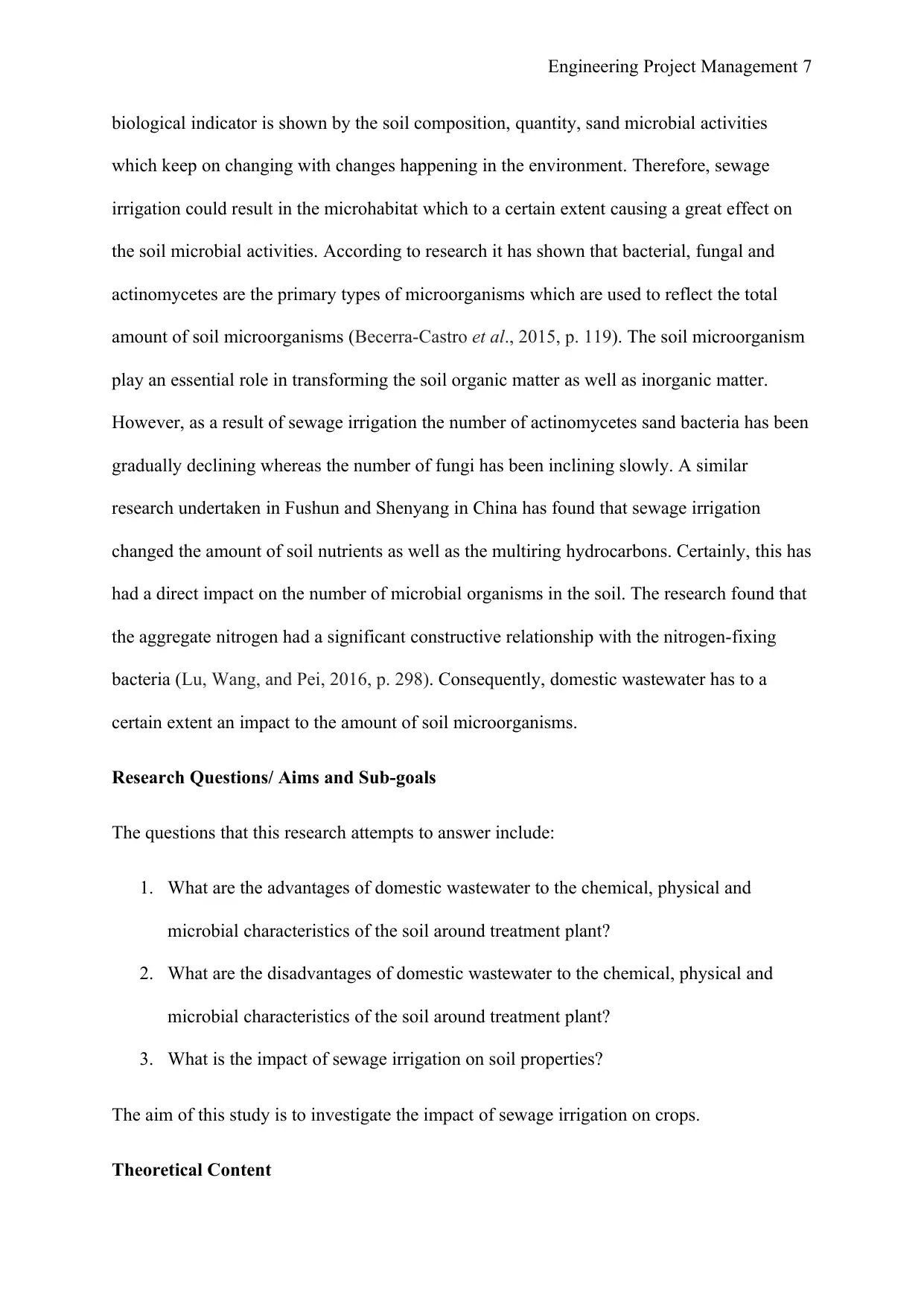
Engineering Project Management 7
biological indicator is shown by the soil composition, quantity, sand microbial activities
which keep on changing with changes happening in the environment. Therefore, sewage
irrigation could result in the microhabitat which to a certain extent causing a great effect on
the soil microbial activities. According to research it has shown that bacterial, fungal and
actinomycetes are the primary types of microorganisms which are used to reflect the total
amount of soil microorganisms (Becerra-Castro et al., 2015, p. 119). The soil microorganism
play an essential role in transforming the soil organic matter as well as inorganic matter.
However, as a result of sewage irrigation the number of actinomycetes sand bacteria has been
gradually declining whereas the number of fungi has been inclining slowly. A similar
research undertaken in Fushun and Shenyang in China has found that sewage irrigation
changed the amount of soil nutrients as well as the multiring hydrocarbons. Certainly, this has
had a direct impact on the number of microbial organisms in the soil. The research found that
the aggregate nitrogen had a significant constructive relationship with the nitrogen-fixing
bacteria (Lu, Wang, and Pei, 2016, p. 298). Consequently, domestic wastewater has to a
certain extent an impact to the amount of soil microorganisms.
Research Questions/ Aims and Sub-goals
The questions that this research attempts to answer include:
1. What are the advantages of domestic wastewater to the chemical, physical and
microbial characteristics of the soil around treatment plant?
2. What are the disadvantages of domestic wastewater to the chemical, physical and
microbial characteristics of the soil around treatment plant?
3. What is the impact of sewage irrigation on soil properties?
The aim of this study is to investigate the impact of sewage irrigation on crops.
Theoretical Content
biological indicator is shown by the soil composition, quantity, sand microbial activities
which keep on changing with changes happening in the environment. Therefore, sewage
irrigation could result in the microhabitat which to a certain extent causing a great effect on
the soil microbial activities. According to research it has shown that bacterial, fungal and
actinomycetes are the primary types of microorganisms which are used to reflect the total
amount of soil microorganisms (Becerra-Castro et al., 2015, p. 119). The soil microorganism
play an essential role in transforming the soil organic matter as well as inorganic matter.
However, as a result of sewage irrigation the number of actinomycetes sand bacteria has been
gradually declining whereas the number of fungi has been inclining slowly. A similar
research undertaken in Fushun and Shenyang in China has found that sewage irrigation
changed the amount of soil nutrients as well as the multiring hydrocarbons. Certainly, this has
had a direct impact on the number of microbial organisms in the soil. The research found that
the aggregate nitrogen had a significant constructive relationship with the nitrogen-fixing
bacteria (Lu, Wang, and Pei, 2016, p. 298). Consequently, domestic wastewater has to a
certain extent an impact to the amount of soil microorganisms.
Research Questions/ Aims and Sub-goals
The questions that this research attempts to answer include:
1. What are the advantages of domestic wastewater to the chemical, physical and
microbial characteristics of the soil around treatment plant?
2. What are the disadvantages of domestic wastewater to the chemical, physical and
microbial characteristics of the soil around treatment plant?
3. What is the impact of sewage irrigation on soil properties?
The aim of this study is to investigate the impact of sewage irrigation on crops.
Theoretical Content
Paraphrase This Document
Need a fresh take? Get an instant paraphrase of this document with our AI Paraphraser
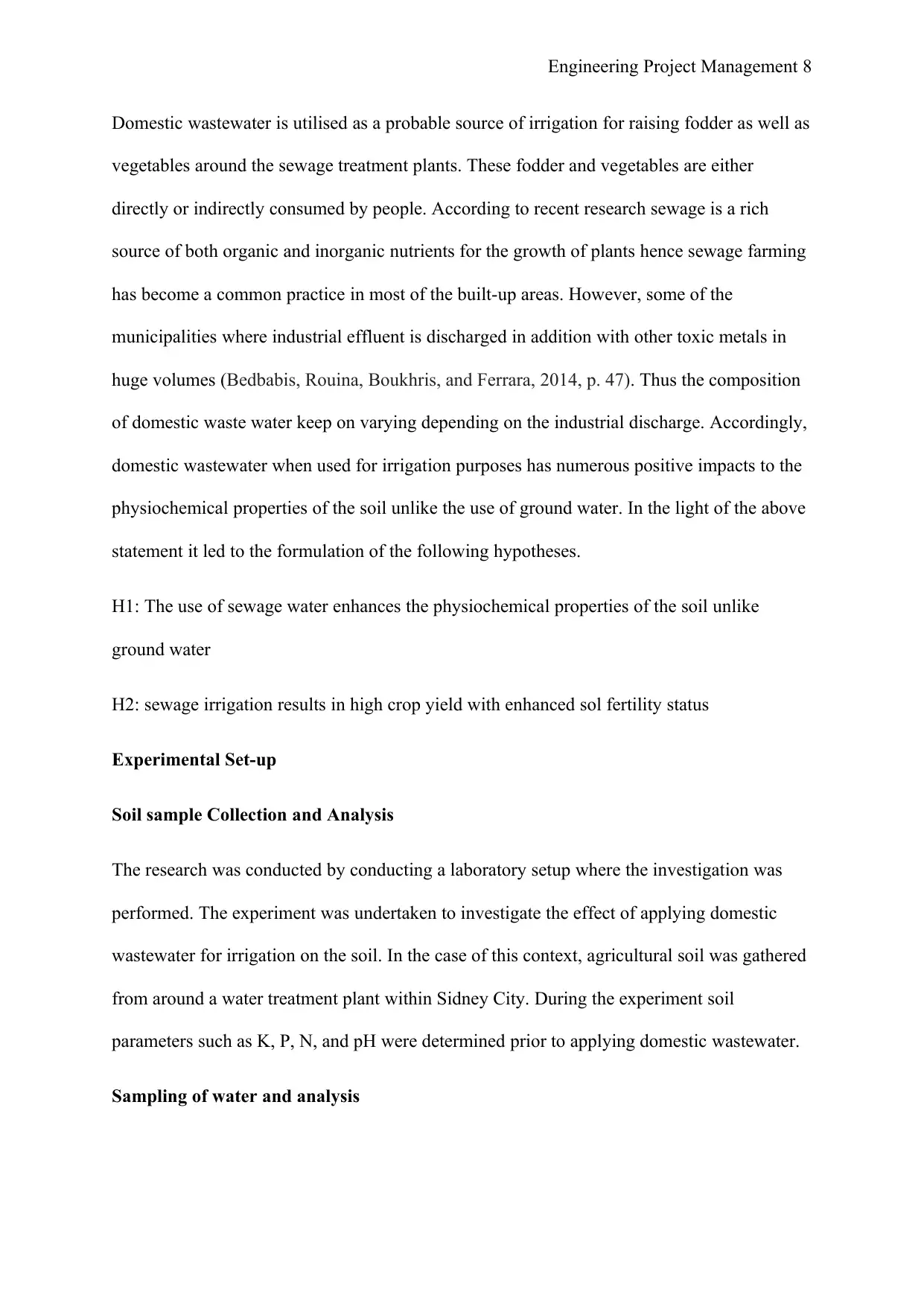
Engineering Project Management 8
Domestic wastewater is utilised as a probable source of irrigation for raising fodder as well as
vegetables around the sewage treatment plants. These fodder and vegetables are either
directly or indirectly consumed by people. According to recent research sewage is a rich
source of both organic and inorganic nutrients for the growth of plants hence sewage farming
has become a common practice in most of the built-up areas. However, some of the
municipalities where industrial effluent is discharged in addition with other toxic metals in
huge volumes (Bedbabis, Rouina, Boukhris, and Ferrara, 2014, p. 47). Thus the composition
of domestic waste water keep on varying depending on the industrial discharge. Accordingly,
domestic wastewater when used for irrigation purposes has numerous positive impacts to the
physiochemical properties of the soil unlike the use of ground water. In the light of the above
statement it led to the formulation of the following hypotheses.
H1: The use of sewage water enhances the physiochemical properties of the soil unlike
ground water
H2: sewage irrigation results in high crop yield with enhanced sol fertility status
Experimental Set-up
Soil sample Collection and Analysis
The research was conducted by conducting a laboratory setup where the investigation was
performed. The experiment was undertaken to investigate the effect of applying domestic
wastewater for irrigation on the soil. In the case of this context, agricultural soil was gathered
from around a water treatment plant within Sidney City. During the experiment soil
parameters such as K, P, N, and pH were determined prior to applying domestic wastewater.
Sampling of water and analysis
Domestic wastewater is utilised as a probable source of irrigation for raising fodder as well as
vegetables around the sewage treatment plants. These fodder and vegetables are either
directly or indirectly consumed by people. According to recent research sewage is a rich
source of both organic and inorganic nutrients for the growth of plants hence sewage farming
has become a common practice in most of the built-up areas. However, some of the
municipalities where industrial effluent is discharged in addition with other toxic metals in
huge volumes (Bedbabis, Rouina, Boukhris, and Ferrara, 2014, p. 47). Thus the composition
of domestic waste water keep on varying depending on the industrial discharge. Accordingly,
domestic wastewater when used for irrigation purposes has numerous positive impacts to the
physiochemical properties of the soil unlike the use of ground water. In the light of the above
statement it led to the formulation of the following hypotheses.
H1: The use of sewage water enhances the physiochemical properties of the soil unlike
ground water
H2: sewage irrigation results in high crop yield with enhanced sol fertility status
Experimental Set-up
Soil sample Collection and Analysis
The research was conducted by conducting a laboratory setup where the investigation was
performed. The experiment was undertaken to investigate the effect of applying domestic
wastewater for irrigation on the soil. In the case of this context, agricultural soil was gathered
from around a water treatment plant within Sidney City. During the experiment soil
parameters such as K, P, N, and pH were determined prior to applying domestic wastewater.
Sampling of water and analysis
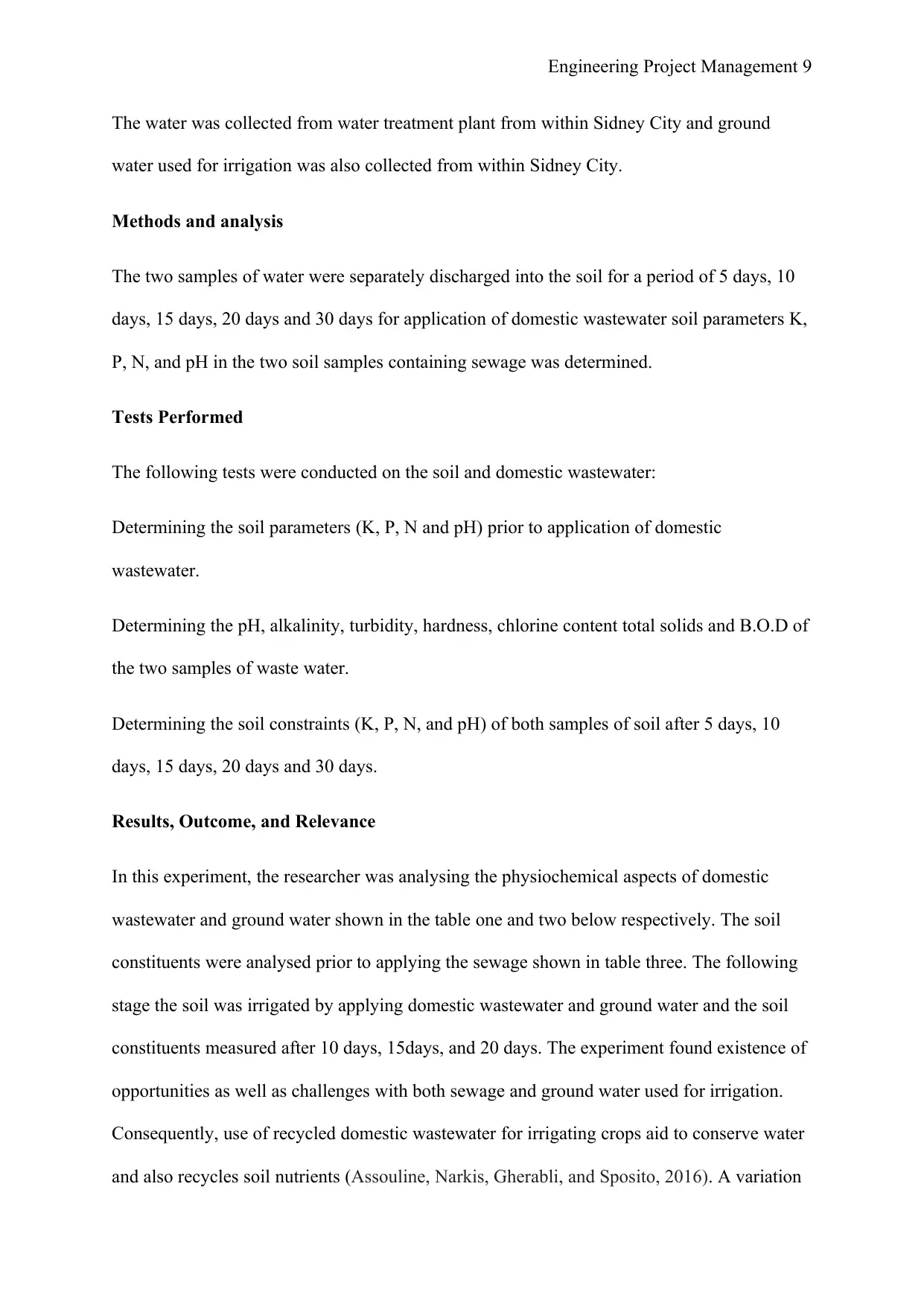
Engineering Project Management 9
The water was collected from water treatment plant from within Sidney City and ground
water used for irrigation was also collected from within Sidney City.
Methods and analysis
The two samples of water were separately discharged into the soil for a period of 5 days, 10
days, 15 days, 20 days and 30 days for application of domestic wastewater soil parameters K,
P, N, and pH in the two soil samples containing sewage was determined.
Tests Performed
The following tests were conducted on the soil and domestic wastewater:
Determining the soil parameters (K, P, N and pH) prior to application of domestic
wastewater.
Determining the pH, alkalinity, turbidity, hardness, chlorine content total solids and B.O.D of
the two samples of waste water.
Determining the soil constraints (K, P, N, and pH) of both samples of soil after 5 days, 10
days, 15 days, 20 days and 30 days.
Results, Outcome, and Relevance
In this experiment, the researcher was analysing the physiochemical aspects of domestic
wastewater and ground water shown in the table one and two below respectively. The soil
constituents were analysed prior to applying the sewage shown in table three. The following
stage the soil was irrigated by applying domestic wastewater and ground water and the soil
constituents measured after 10 days, 15days, and 20 days. The experiment found existence of
opportunities as well as challenges with both sewage and ground water used for irrigation.
Consequently, use of recycled domestic wastewater for irrigating crops aid to conserve water
and also recycles soil nutrients (Assouline, Narkis, Gherabli, and Sposito, 2016). A variation
The water was collected from water treatment plant from within Sidney City and ground
water used for irrigation was also collected from within Sidney City.
Methods and analysis
The two samples of water were separately discharged into the soil for a period of 5 days, 10
days, 15 days, 20 days and 30 days for application of domestic wastewater soil parameters K,
P, N, and pH in the two soil samples containing sewage was determined.
Tests Performed
The following tests were conducted on the soil and domestic wastewater:
Determining the soil parameters (K, P, N and pH) prior to application of domestic
wastewater.
Determining the pH, alkalinity, turbidity, hardness, chlorine content total solids and B.O.D of
the two samples of waste water.
Determining the soil constraints (K, P, N, and pH) of both samples of soil after 5 days, 10
days, 15 days, 20 days and 30 days.
Results, Outcome, and Relevance
In this experiment, the researcher was analysing the physiochemical aspects of domestic
wastewater and ground water shown in the table one and two below respectively. The soil
constituents were analysed prior to applying the sewage shown in table three. The following
stage the soil was irrigated by applying domestic wastewater and ground water and the soil
constituents measured after 10 days, 15days, and 20 days. The experiment found existence of
opportunities as well as challenges with both sewage and ground water used for irrigation.
Consequently, use of recycled domestic wastewater for irrigating crops aid to conserve water
and also recycles soil nutrients (Assouline, Narkis, Gherabli, and Sposito, 2016). A variation
⊘ This is a preview!⊘
Do you want full access?
Subscribe today to unlock all pages.

Trusted by 1+ million students worldwide
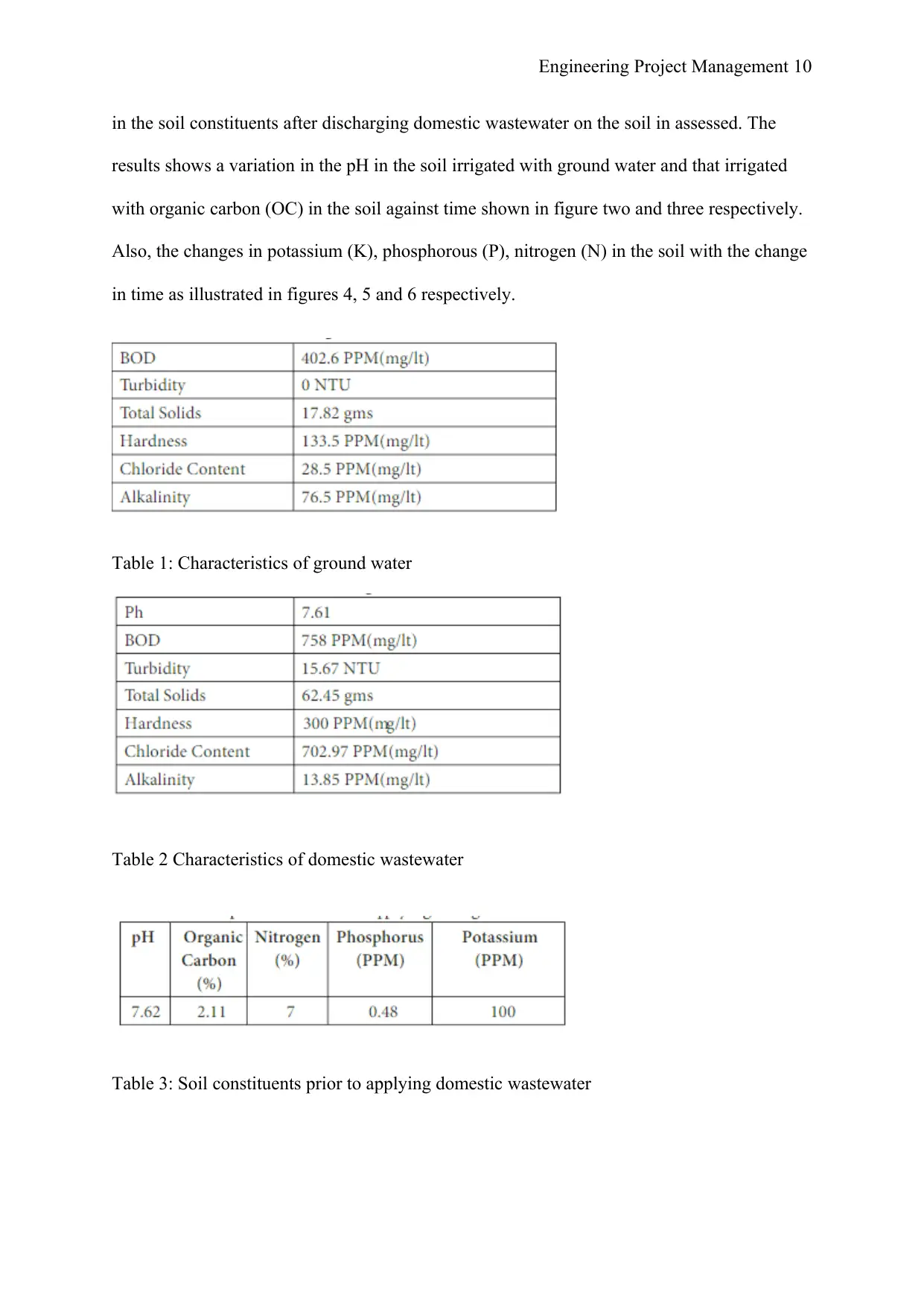
Engineering Project Management 10
in the soil constituents after discharging domestic wastewater on the soil in assessed. The
results shows a variation in the pH in the soil irrigated with ground water and that irrigated
with organic carbon (OC) in the soil against time shown in figure two and three respectively.
Also, the changes in potassium (K), phosphorous (P), nitrogen (N) in the soil with the change
in time as illustrated in figures 4, 5 and 6 respectively.
Table 1: Characteristics of ground water
Table 2 Characteristics of domestic wastewater
Table 3: Soil constituents prior to applying domestic wastewater
in the soil constituents after discharging domestic wastewater on the soil in assessed. The
results shows a variation in the pH in the soil irrigated with ground water and that irrigated
with organic carbon (OC) in the soil against time shown in figure two and three respectively.
Also, the changes in potassium (K), phosphorous (P), nitrogen (N) in the soil with the change
in time as illustrated in figures 4, 5 and 6 respectively.
Table 1: Characteristics of ground water
Table 2 Characteristics of domestic wastewater
Table 3: Soil constituents prior to applying domestic wastewater
Paraphrase This Document
Need a fresh take? Get an instant paraphrase of this document with our AI Paraphraser
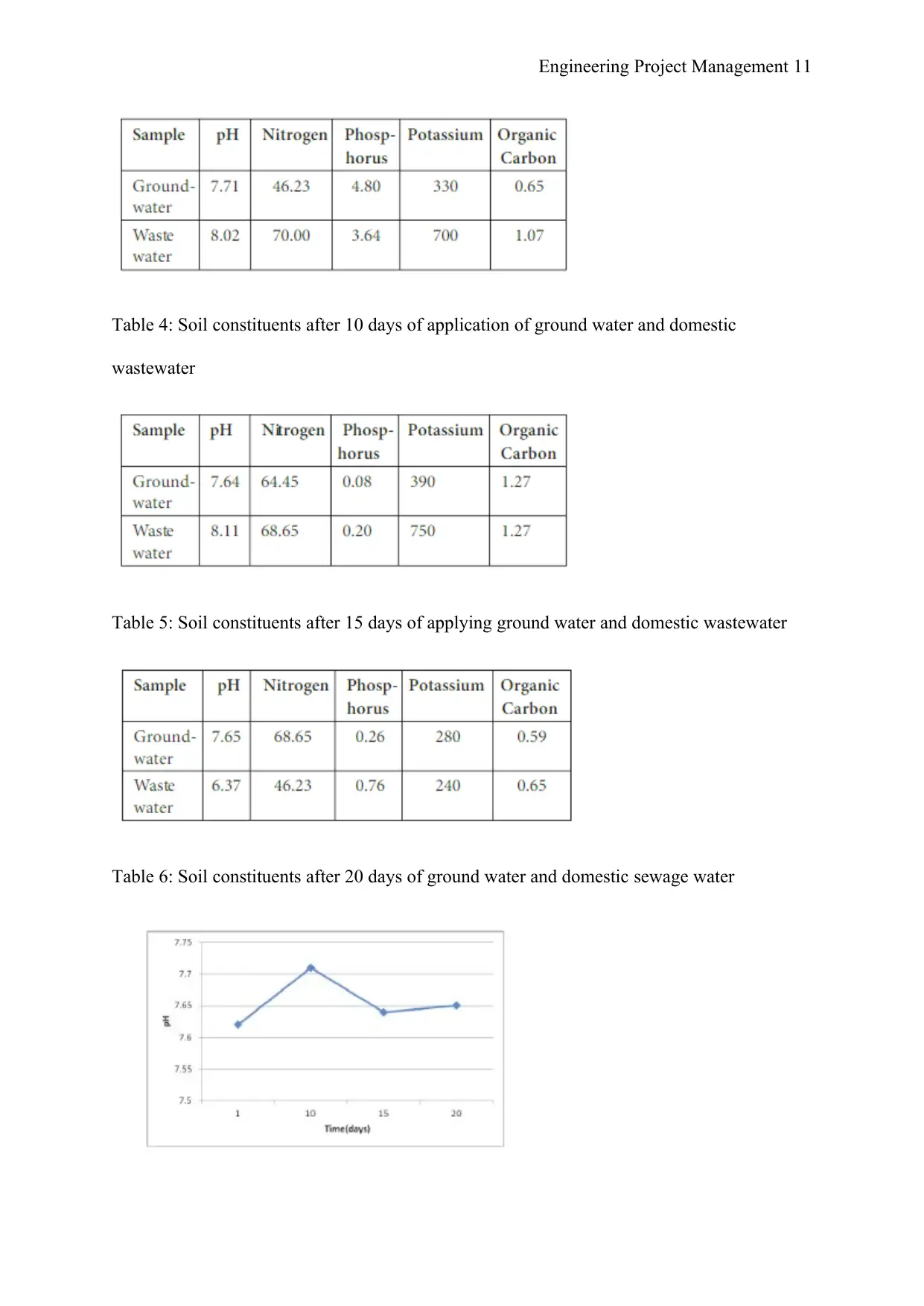
Engineering Project Management 11
Table 4: Soil constituents after 10 days of application of ground water and domestic
wastewater
Table 5: Soil constituents after 15 days of applying ground water and domestic wastewater
Table 6: Soil constituents after 20 days of ground water and domestic sewage water
Table 4: Soil constituents after 10 days of application of ground water and domestic
wastewater
Table 5: Soil constituents after 15 days of applying ground water and domestic wastewater
Table 6: Soil constituents after 20 days of ground water and domestic sewage water
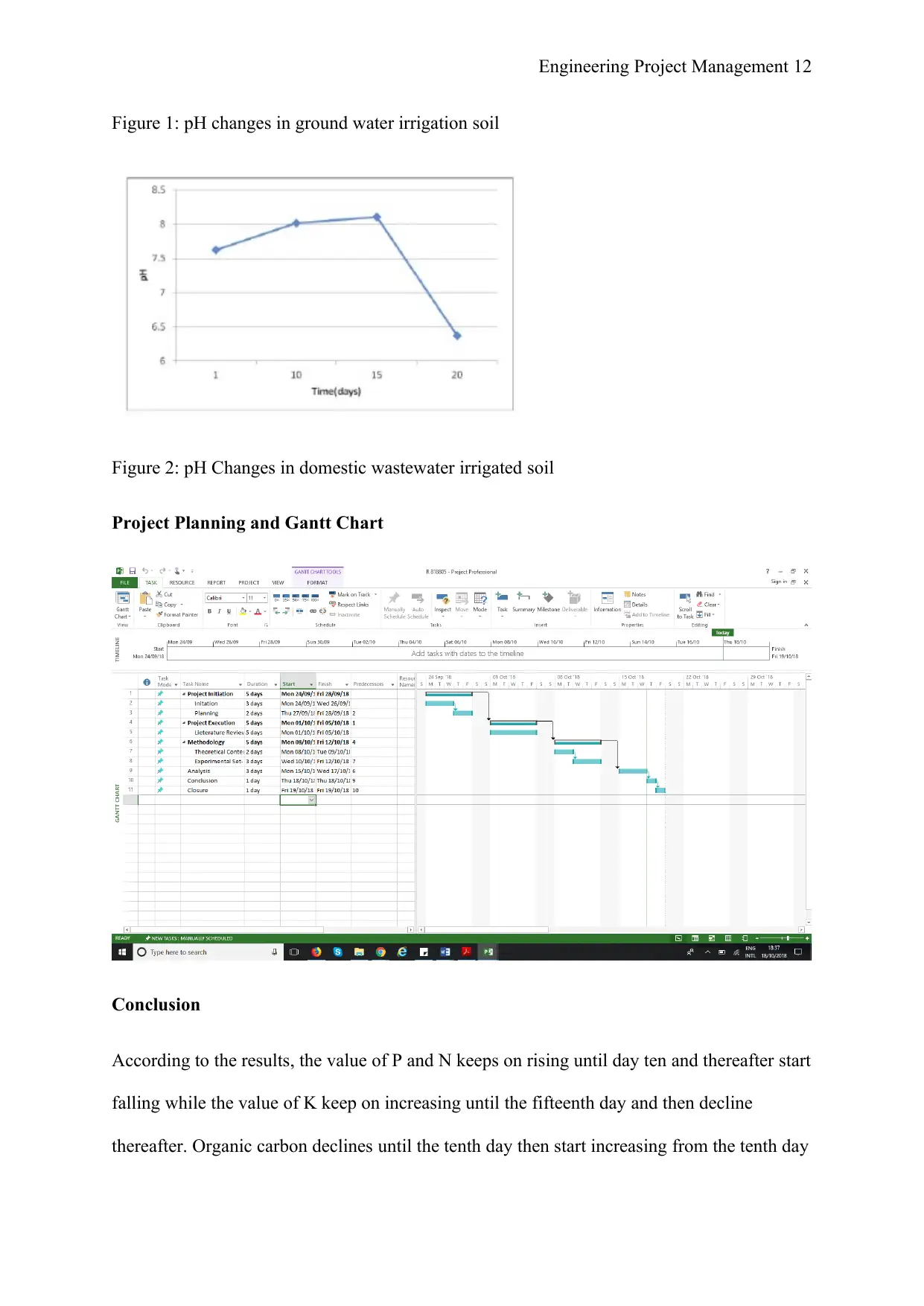
Engineering Project Management 12
Figure 1: pH changes in ground water irrigation soil
Figure 2: pH Changes in domestic wastewater irrigated soil
Project Planning and Gantt Chart
Conclusion
According to the results, the value of P and N keeps on rising until day ten and thereafter start
falling while the value of K keep on increasing until the fifteenth day and then decline
thereafter. Organic carbon declines until the tenth day then start increasing from the tenth day
Figure 1: pH changes in ground water irrigation soil
Figure 2: pH Changes in domestic wastewater irrigated soil
Project Planning and Gantt Chart
Conclusion
According to the results, the value of P and N keeps on rising until day ten and thereafter start
falling while the value of K keep on increasing until the fifteenth day and then decline
thereafter. Organic carbon declines until the tenth day then start increasing from the tenth day
⊘ This is a preview!⊘
Do you want full access?
Subscribe today to unlock all pages.

Trusted by 1+ million students worldwide
1 out of 16
Your All-in-One AI-Powered Toolkit for Academic Success.
+13062052269
info@desklib.com
Available 24*7 on WhatsApp / Email
![[object Object]](/_next/static/media/star-bottom.7253800d.svg)
Unlock your academic potential
Copyright © 2020–2025 A2Z Services. All Rights Reserved. Developed and managed by ZUCOL.